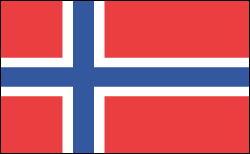Norway
 National name: Kongeriket Norge Sovereign: King Harald V (1991) Prime Minister: Jens Stoltenberg (2005) Land area: 118,865 sq mi (307,860 sq km); total area: 125,181 sq mi (324,220 sq km) Population (2007 est.): 4,627,926 (growth rate: 0.4%); birth rate: 11.3/1000; infant mortality rate: 3.6/1000; life expectancy: 79.7; density per sq mi: 39 Capital and largest city (2003 est.): Oslo, 791,500 Other large cities: Bergen, 211,200; Stavanger, 168,600; Trondheim, 144,000 Monetary unit: Norwegian krone Languages: Bokmål Norwegian, Nynorsk Norwegian (both official); small Sami- and Finnish-speaking minorities (Sami is official in six municipalities) Ethnicity/race: Norwegian, Sami 20,000 Religions: Evangelical Lutheran 86% (state church), Pentecostal 1%, Roman Catholic 1%, other Christian 2% (2004) Literacy rate: 100% (2003 est.) Economic summary: GDP/PPP (2005 est.): $194.7 billion; per capita $42,400. Real growth rate: 3.7%. Inflation: 2.1%. Unemployment: 4.2%. Arable land: 3%. Agriculture: barley, wheat, potatoes; pork, beef, veal, milk; fish. Labor force: 2.4 million; services 74%, industry 22%, agriculture, forestry, and fishing 4% (1995). Industries: petroleum and gas, food processing, shipbuilding, pulp and paper products, metals, chemicals, timber, mining, textiles, fishing. Natural resources: petroleum, copper, natural gas, pyrites, nickel, iron ore, zinc, lead, fish, timber, hydropower. Exports: $111.2 billion f.o.b. (2005 est.): petroleum and petroleum products, machinery and equipment, metals, chemicals, ships, fish. Imports: $58.12 billion f.o.b. (2005 est.): machinery and equipment, chemicals, metals, foodstuffs. Major trading partners: UK, Germany, Netherlands, France, U.S., Sweden, Denmark, China, Finland (2004). Communications: Telephones: main lines in use: 2.735 million (1998); mobile cellular: 2,080,408 (1998). Radio broadcast stations: AM 5, FM at least 650, shortwave 1 (1998). Radios: 4.03 million (1997). Television broadcast stations: 360 (plus 2,729 repeaters) (1995). Televisions: 2.03 million (1997). Internet Service Providers (ISPs): 13 (2000). Internet users: 2.68 million (2002). Transportation: Railways: total: 4,178 km (2002). Highways: total: 91,454 km; paved: 69,505 km (including 143 km of expressways); unpaved: 21,949 km (2000). Waterways: 1,577 km along west coast; navigable by 2.4 m draft vessels maximum. Ports and harbors: Bergen, Drammen, Floro, Hammerfest, Harstad, Haugesund, Kristiansand, Larvik, Narvik, Oslo, Porsgrunn, Stavanger, Tromso, Trondheim. Airports: 102 (2002). International disputes: Norway asserts a territorial claim in Antarctica (Queen Maud Land and its continental shelf); despite recent discussions, Russia and Norway continue to dispute their maritime limits in the Barents Sea and Russia's fishing rights beyond Svalbard's territorial limits within the Svalbard Treaty zone. |
Geography
Norway is situated in the western part of the Scandinavian peninsula. It extends about 1,100 mi (1,770 km) from the North Sea along the Norwegian Sea to more than 300 mi (483 km) above the Arctic Circle, the farthest north of any European country. It is slightly larger than New Mexico. Nearly 70% of Norway is uninhabitable and covered by mountains, glaciers, moors, and rivers. The hundreds of deep fjords that cut into the coastline give Norway an overall oceanfront of more than 12,000 mi (19,312 km). Galdhø Peak, at 8,100 ft (2,469 m), is Norway's highest point and the Glåma (Glomma) is the principal river, at 372 mi (598 km) long.
Government
Constitutional monarchy.
History
Norwegians, like the Danes and Swedes, are of Teutonic origin. The Norsemen, also known as Vikings, ravaged the coasts of northwest Europe from the 8th to the 11th century and were ruled by local chieftains. Olaf II Haraldsson became the first effective king of all Norway in 1015 and began converting the Norwegians to Christianity. After 1442, Norway was ruled by Danish kings until 1814, when it was united with Sweden—although retaining a degree of independence and receiving a new constitution—in an uneasy partnership. In 1905, the Norwegian parliament arranged a peaceful separation and invited a Danish prince to the Norwegian throne—King Haakon VII. A treaty with Sweden provided that all disputes be settled by arbitration and that no fortifications be erected on the common frontier.
When World War I broke out, Norway joined with Sweden and Denmark in a decision to remain neutral and to cooperate in the joint interest of the three countries. In World War II, Norway was invaded by the Germans on April 9, 1940. It resisted for two months before the Nazis took complete control. King Haakon and his government fled to London, where they established a government-in-exile. Maj. Vidkun Quisling, who served as Norway's prime minister during the war, was the most notorious of the Nazi collaborators. The word for traitor, quisling, bears his name. He was executed by the Norwegians on Oct. 24, 1945. Despite severe losses in the war, Norway recovered quickly as its economy expanded. It joined NATO in 1949.
In the late 20th century, the Labor Party and the Conservative Party seesawed for control, each sometimes having to lead minority governments. An important debate was over Norway's membership in the European Union. In an advisory referendum held in Nov. 1994, voters rejected seeking membership for their nation in the EU. The country became the second-largest oil exporter after Saudi Arabia in 1995. Norway continued to experience rapid economic growth into the new millennium.
In March 2000, Prime Minister Kjell Magne Bondevik resigned after parliament voted to build the country's first gas-fired power stations. Bondevik had objected to the project, asserting that the plants would emit too much carbon dioxide. Labor Party leader Jens Stoltenberg succeeded Bondevik. Stoltenberg and the Labor Party were defeated in Sept. 2001 elections, and no party emerged with a clear majority. After a month of talks, the Conservatives, the Christian People's Party, and the Liberals formed a coalition with Bondevik as prime minister. The governing coalition was backed by the far-right Progress Party. But in Sept. 2005 elections, the center-left Red-Green coalition gained a majority of seats, and Jens Stoltenberg of the Labor Party once again became prime minister.
Hiç yorum yok:
Yorum Gönder